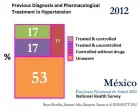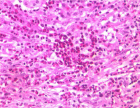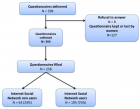Abstract
Research Article
Efficacies of 11% Lactoferricin and 0.05% Chlorhexidine Otological Solution compared, in the treatment of microbial otic overgrowth: A randomized single blinded study
Luisa Cornegliani*, Federico Leone, Francesco Albanese, Mauro Bigliati, Natalia Fanton and Antonella Vercelli
Published: 04 October, 2017 | Volume 1 - Issue 1 | Pages: 032-041
Background:Topical therapy with antimicrobial agents is used in otitis treatment. Due to increase of antibiotic resistance, new strategies are needed. Antiseptics are used but they may induce contact dermatitis. Natural antimicrobial peptides may represent future effective drugs.
Objectives:The objectives were to test the efficacy of an 11% lactoferricin otological solution (LCF) in bacterial and yeasts otic overgrowth and compare LCF with a commercial one containing chlorhexidine (CLX) 0.05%.
Materials and methods:Forty-one dogs diagnosed with bacterial or yeasts otitis overgrowths were included according to general good practice. They were randomly assigned to lactoferricin or chlorhexidine group for treatment. Otological solution were applied twice a day for a week and then daily for another week. Clinical and cytological score was assessed at day 1 and day 14. At the end of the study, the owners had to express an opinion on the overall efficacy of the products. Statistical analyses were performed using Wilkoxon’s test and T test for paired samples. Results in lesional and cytological score were significative with a p<0.05.
Results:Forty dogs completed the study. All cases, receiving lactoferricin or chlorhexidine, were successfully treated with clinical signs remission and regression of infection (p<0.05). The owners’ judgment was good in 87%, mild in 13% for LCF group. For CLX they scored good in 41%, mild in 24% and unuseful in 35% of cases.
Conclusions:Lactoferricin, an antimicrobial natural peptide, showed the same efficacy of chlorhexidine in the treatment of otitis characterized by bacterial or/and yeast overgrowth.
Read Full Article HTML DOI: 10.29328/journal.ivs.1001004 Cite this Article Read Full Article PDF
References
- Miller WH, Griffin CE, Campbell KL. Diseases of the eyelids, claws, anal sacs and ears. In Muller and Kirk’s small animal dermatology. Elsevier Mosby. St Luis, VII ed. 2013; 724.
- Jacobson LS. Diagnosis and medical treatment of otitis externa in the dog and cat. J S Afr Vet Assoc. 2002; 73: 162-170. Ref.: https://goo.gl/EHxjCX
- Nuttal T. Successful management of otitis externa. In Pract. 2016; 38: 17-21.
- Guardabassi L, Houser GA, Frank LA. Guidelines for antimicrobial use in small animals. In: Guardabassi L, Jensen LB, Hilde K. eds. Guide to Antimicrobial Use in Animals. Oxford: Blackwell Publishing. 2008; 183-120.
- Laxminarayan R, Duse A, Wattal C, Zaidi AK, Wertheim HF, et al. Antibiotic resistance-the need for global solutions. Lancet.2013; 13: 1057-1098. Ref.: https://goo.gl/PP9GN9
- Loeffler A, Linek M, Moodley A, Guardabassi L, Sung JM, et al. First report of multiresistant, mecA-positive Staphylococcus intermedius in Europe: 12 cases from a veterinary dermatology referral clinic in Germany. Vet Dermatol. 2007; 18: 412-421. Ref.: https://goo.gl/9BCjjR
- Morris DO. Medical therapy of otitis externa and otitis media. Vet Clin North Am Small Anim Pract. 2004; 34: 541-545. Ref.: https://goo.gl/Zvdkaf
- Kuyyakanond T, Quesnel LB. The mechanism of action of chlorhexidine. FEMS Microbiol Lett. 1992; 79: 211-215. Ref.: https://goo.gl/owfTXg
- Guardabassi L, Ghibaudo G, Damborg P. In vitro antimicrobial activity of a commercial ear antiseptic containing chlorhexidine and Tris-EDTA. Vet Dermatol. 2010; 21: 282-286. Ref.: https://goo.gl/THzmS9
- Galle HG, Venker-van Haagen, A J. Ototoxicity of the antiseptic combination chlorhexidine/cetrimide (Savlon): effects on equilibrium and hearing. Vet Q. 1986; 8: 56-60. Ref: https://goo.gl/JDPC1r
- Igarashi Y, Oka Y. Vestibular ototoxicity following intratympanic applications of chlorhexidine gluconate in the cat. Arch Otorhinolaryngol. 1988; 245: 210-217. Ref.: https://goo.gl/z14mq5
- Abdallah C. Perioperative chlorhexidine allergy: Is it serious? J Anaesthesiol Clin Pharmacol. 2015; 31: 152-154. Ref.: https://goo.gl/hUvJdr
- Opstrup MS, Johansen JD, Zachariae C, Garvey LH. Contact allergy to chlorhexidine in a tertiary dermatology clinic in Denmark. Contact Dermatitis. 2016; 74: 29-36. Ref.: https://goo.gl/h5EEJn
- Lachapelle JM. A comparison of the irritant and allergenic properties of antiseptics. Eur J Dermatol. 2014; 24: 3-9. Ref.: https://goo.gl/GkSS7U
- Colagiuri GF, Di Leo E, Trautmann N, Ferrannini A, Vacca A. Chlorhexidine hypersensitivity: a critical and updated review. J Allergy Ther. 2013; 4: 4-10. Ref.: https://goo.gl/jNzJMK
- Bruni N, Capucchio MT, Biasiletti E, Enrica Pessione, Simona Cirrincione, et al. Antimicrobial activity of lactoferricin-related peptides and applications in human and veterinary medicine. Molecules. 2016; 21: 752. Ref.: https://goo.gl/LTKwZH
- Cafarchia C, Immediato D, Di Paola G, Magliani W, Ciociola T, et al. In vitro and in vivo activity of a killer peptide against Malassezia pachydermatis causing otitis in dog. Med Mycol. 2014; 52: 350-355. Ref.: https://goo.gl/MMSu9K
- Yin C, Wong Jh, Ng TB. Recent studies on antimicrobial peptides lactoferricin and lactoferrampin. Curr Mol Med. 2014; 4: 1139-1154. Ref.: https://goo.gl/H1zGLv
- Vercelli A, Fanton N, Bruni N, Vergano D, Bigliati M, et al. Use of lactoferricin, verbascoside and glycerophosphoinositol emulsion in otitis externa treatment: a pilot study. Veterinaria. 2015; 29: 49-57. Ref.: https://goo.gl/UbnT6p
- Nuttall T, Bensignor E. A pilot study to develop an objective clinical score for canine otitis externa. Vet Dermatol. 2014; 25: 530-537. Ref.: https://goo.gl/Uo1QFu
- Ginel JP, Lucena R, Rodriguez JC, Ortega J. A semiquantitative cytological evaluation of normal and pathological samples from the external ear canal of dog and cats. Vet Dermatol. 2002; 13: 151-156. Ref.: https://goo.gl/PLPfmb
- Negre A, Bensignor E, Guillot J. Evidence-based veterinary dermatology: a systematic review of interventions for Malassezia dermatitis in dogs. Vet Dermatol. 2009; 20: 1-12. Ref.: https://goo.gl/bTURvp
- Calnan CD. Contact Dermatitis from drugs. Proc R Soc Med.1962; 55: 39-42. Ref.: https://goo.gl/QfkijD
- Porter BJ, Acharya U, Ormerod AD, Herriot R. Latex/chlorhexidine-induced anaphylaxis in pregnancy. Allergy. 1998; 53: 455-457. Ref.: https://goo.gl/rtijXc
- Dashper SG, Liu SW, Reynolds EC. Antimicrobial peptides and their potential as oral therapeutic agents. Int J Pept Res Ther 2007; 13: 505-516. Ref.: https://goo.gl/yZnzfm
- Guilhelmelli F, Vilela N, Albuquerque P, Derengowski Lda S, Silva-Pereira I, et al. Antibiotic development challenges: the various mechanisms of action of antimicrobial peptides and of bacterial resistance. Front Microbiol. 2013; 4: 1-12. Ref.: https://goo.gl/jT2WSY
- Brandenburg K, Schürholz T. Lack of new anti-infective agents: Passing into the pre-antibiotic age? World J Biol Chem. 2015; 26: 71-77. Ref.: https://goo.gl/Qk6MNe
- Corona A, Vercelli A, Bruni N, Cornegliani L. In vitro bactericidal activity of lactoferricin and other enzymes on bacteria selected from dogs with pyoderma. Vete Dermatol. 2016; 27: 54.
- Cornegliani L, Corona A, Vercelli A: Use of lactoferricin, verbascoside and glycerophosphoinositole lysine emulsion in bacterial and yeast overgrowth treatment: a pilot study in ten dogs. Vet Dermat. 2016; 27: 72.
- Afanasev IB. Superoxide and nitric oxide in pathological conditions associated with iron overload: the effects of antioxidants and chelators. Curr Med Chem. 2005; 12: 2731-2739. Ref.: https://goo.gl/UDCHY3
- Vertuani S, Beghelli E, La Scalambra E, Malisardi G, Copetti S, et al. Activity and stability studies of verbascoside, a novel antioxidant, in dermo-cosmetic and pharmaceutical topical formulations. Molecules. 2011; 16: 7068-7080. Ref.: https://goo.gl/isMrk4
Figures:
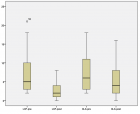
Figure 1
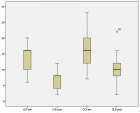
Figure 2
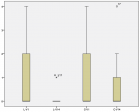
Figure 3
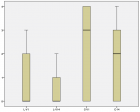
Figure 4
Similar Articles
-
Exploring novel medical applications for commonly used veterinary drug (tilmicosin antibiotic)Fatma I Abo El-Ela*,El-Banna HA. Exploring novel medical applications for commonly used veterinary drug (tilmicosin antibiotic). . 2017 doi: 10.29328/journal.ivs.1001001; 1: 001-016
-
Investigation on Theileria lestoquardi infection among sheep and goats in Nyala, South Darfur State, SudanOsman TM,Ali AM*,Hussein MO,El Ghali A,Salih DA. Investigation on Theileria lestoquardi infection among sheep and goats in Nyala, South Darfur State, Sudan. . 2017 doi: 10.29328/journal.ivs.1001002; 1: 017-023
-
Mechanism-related Teratogenic, Hormone Modulant and other Toxicological effects of Veterinary and agricultural surfactantsAndrás Székács*. Mechanism-related Teratogenic, Hormone Modulant and other Toxicological effects of Veterinary and agricultural surfactants. . 2017 doi: 10.29328/journal.ivs.1001003; 1: 024-031
-
Efficacies of 11% Lactoferricin and 0.05% Chlorhexidine Otological Solution compared, in the treatment of microbial otic overgrowth: A randomized single blinded studyLuisa Cornegliani*,Federico Leone,Francesco Albanese,Mauro Bigliati,Natalia Fanton,Antonella Vercelli. Efficacies of 11% Lactoferricin and 0.05% Chlorhexidine Otological Solution compared, in the treatment of microbial otic overgrowth: A randomized single blinded study. . 2017 doi: 10.29328/journal.ivs.1001004; 1: 032-041
-
Ocular surface Rose Bengal staining in normal dogs and dogs with Keratoconjunctivitis Sicca: Preliminary findingsWilliams DL*,Griffiths A. Ocular surface Rose Bengal staining in normal dogs and dogs with Keratoconjunctivitis Sicca: Preliminary findings. . 2017 doi: 10.29328/journal.ivs.1001005; 1: 042-046
-
Influence of Vitamin E on the Disposition Kinetics of Florfenicol after single and multiple oral administrations in Broiler ChickensFatma Ibrahim Abo El-Ela*,Hossny Awad El-Banna,Manal B El-Deen,Tohamy MA. Influence of Vitamin E on the Disposition Kinetics of Florfenicol after single and multiple oral administrations in Broiler Chickens. . 2017 doi: 10.29328/journal.ivs.1001006; 1: 047-057
-
Effects of carazolol on electrocadiographic and trace element status in sheepsRemzi Gonul,Lora Koenhemsı,Handan Aydın Vural*,Tevfik Gulyasar,Hasret Demırcan Yardıbı,Erman OR,Bora Barutcu. Effects of carazolol on electrocadiographic and trace element status in sheeps. . 2018 doi: 10.29328/journal.ivs.1001007; 2: 001-004
-
Livestock insurance a tool to reduce economical loss of farmers from climate change related HazardsAnanta Koirala*,Priyanka Bhandari. Livestock insurance a tool to reduce economical loss of farmers from climate change related Hazards. . 2018 doi: 10.29328/journal.ivs.1001008; 2: 005-008
-
The failure to provide an effective veterinary service to sheep in AustraliaJAL Maxwell*. The failure to provide an effective veterinary service to sheep in Australia. . 2018 doi: 10.29328/journal.ivs.1001009; 2: 009-017
-
Does Veterinary Science have a future in Australia?JAL Maxwell*. Does Veterinary Science have a future in Australia?. . 2018 doi: 10.29328/journal.ivs.1001010; 2: 018-026
Recently Viewed
-
Breast Imaging Services Utilization Trends Across Private and Government-Insured Patients in a National Radiology PracticeAndrew K Hillman*,Phil Ramis,Patrick Nielsen,Sophia N Swanston,Dana Bonaminio,Eric M Rohren. Breast Imaging Services Utilization Trends Across Private and Government-Insured Patients in a National Radiology Practice. J Clin Med Exp Images. 2025: doi: 10.29328/journal.jcmei.1001037; 9: 020-027
-
Characterization of Salmonella spp. isolated from small turtles and human in Republic of KoreaSu-Jin Chae,Jin-Suk Lim,Deog-Yong Lee*. Characterization of Salmonella spp. isolated from small turtles and human in Republic of Korea. Insights Vet Sci. 2020: doi: 10.29328/journal.ivs.1001027; 4: 051-055
-
Screening for Depressive Symptoms in Clinical and Nonclinical Youth: The Psychometric Properties of the Dutch Children’s Depression Inventory-2 (CDI-2)Denise HM Bodden*,Yvonne Stikkelbroek,Daan Creemers,Sanne PA Rasing,Elien De Caluwe,Caroline Braet. Screening for Depressive Symptoms in Clinical and Nonclinical Youth: The Psychometric Properties of the Dutch Children’s Depression Inventory-2 (CDI-2). Insights Depress Anxiety. 2025: doi: 10.29328/journal.ida.1001047; 9: 028-039
-
The Bacteriological Profile of Nosocomial Infections at the Army Central Hospital of BrazzavilleMedard Amona*,Yolande Voumbo Matoumona Mavoungou,Hama Nemet Ondzotto,Benjamin Kokolo,Armel Itoua,Gilius Axel Aloumba,Pascal Ibata. The Bacteriological Profile of Nosocomial Infections at the Army Central Hospital of Brazzaville. Int J Clin Microbiol Biochem Technol. 2025: doi: 10.29328/journal.ijcmbt.1001032; 8: 009-022
-
Breast Cancer in FemaleLorena Menditto*. Breast Cancer in Female. Arch Cancer Sci Ther. 2024: doi: 10.29328/journal.acst.1001040; 8: 013-018
Most Viewed
-
Impact of Latex Sensitization on Asthma and Rhinitis Progression: A Study at Abidjan-Cocody University Hospital - Côte d’Ivoire (Progression of Asthma and Rhinitis related to Latex Sensitization)Dasse Sery Romuald*, KL Siransy, N Koffi, RO Yeboah, EK Nguessan, HA Adou, VP Goran-Kouacou, AU Assi, JY Seri, S Moussa, D Oura, CL Memel, H Koya, E Atoukoula. Impact of Latex Sensitization on Asthma and Rhinitis Progression: A Study at Abidjan-Cocody University Hospital - Côte d’Ivoire (Progression of Asthma and Rhinitis related to Latex Sensitization). Arch Asthma Allergy Immunol. 2024 doi: 10.29328/journal.aaai.1001035; 8: 007-012
-
Causal Link between Human Blood Metabolites and Asthma: An Investigation Using Mendelian RandomizationYong-Qing Zhu, Xiao-Yan Meng, Jing-Hua Yang*. Causal Link between Human Blood Metabolites and Asthma: An Investigation Using Mendelian Randomization. Arch Asthma Allergy Immunol. 2023 doi: 10.29328/journal.aaai.1001032; 7: 012-022
-
An algorithm to safely manage oral food challenge in an office-based setting for children with multiple food allergiesNathalie Cottel,Aïcha Dieme,Véronique Orcel,Yannick Chantran,Mélisande Bourgoin-Heck,Jocelyne Just. An algorithm to safely manage oral food challenge in an office-based setting for children with multiple food allergies. Arch Asthma Allergy Immunol. 2021 doi: 10.29328/journal.aaai.1001027; 5: 030-037
-
Snow white: an allergic girl?Oreste Vittore Brenna*. Snow white: an allergic girl?. Arch Asthma Allergy Immunol. 2022 doi: 10.29328/journal.aaai.1001029; 6: 001-002
-
Cytokine intoxication as a model of cell apoptosis and predict of schizophrenia - like affective disordersElena Viktorovna Drozdova*. Cytokine intoxication as a model of cell apoptosis and predict of schizophrenia - like affective disorders. Arch Asthma Allergy Immunol. 2021 doi: 10.29328/journal.aaai.1001028; 5: 038-040

If you are already a member of our network and need to keep track of any developments regarding a question you have already submitted, click "take me to my Query."






